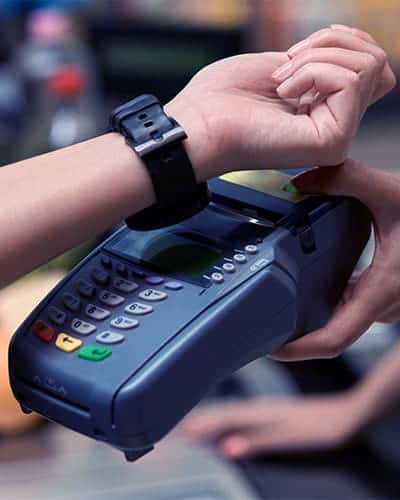Guide
Decrypting Cryptocurrency Payments
A payments guide for processing digital currencies.
On This Page
What is cryptocurrency?
Cryptocurrency, often abbreviated to “crypto,” is a form of virtual currency. Compared to traditional fiat currency, cryptocurrencies are decentralized, meaning they aren’t monitored or owned by governments or central banks. This decentralization eliminates the need for a traditional payments middleman and any additional costs for cross-border transactions.
Cryptocurrencies are created through a technical process known as “mining,” which Coinbase defines as “a process by which networks of specialized computers generate and release new [coins] and verify new transactions.”
Cryptocurrencies rely on blockchain, a decentralized network of all transactions across a peer-to-peer network, and Web 3.0, a version of the internet based on public blockchains. The name “crypto” highlights the system of encryption that all cryptocurrencies use, which ensures that all transactions are anonymized; blockchain and Web 3.0 support the decentralized nature of cryptocurrencies, ensuring the transparency of all transactions.
Cryptocurrencies are being adopted across all age groups. Although younger generations are driving high adoption rates, with Millennials and Gen Z accounting for 94% of all crypto buyers, older generations aren’t far behind them, with Gen X outspending Millennials and Gen Z at an average of $9,611 in crypto purchases. In order to embrace this trend and accept cryptocurrency payments, merchants must implement a cryptocurrency payments gateway.
What is the difference between cryptocurrency and digital currency?
The issuance of the first cryptocurrency, Bitcoin, in 2009 prompted governments to define less volatile, more reliable forms of currency for consumers. These currencies — known as digital currencies — have all been developed on the Web 3.0 platform and include:
- Stablecoins (any virtual currency backed by a stable asset, such as valuable metals)
- Central Bank Digital Currencies (CBDC)
- Virtual forms of fiat currencies
Is cryptocurrency accepted as a legal tender?
Yes. In some parts of the world, cryptocurrencies have already been identified as a taxable asset; for example, in the U.S., all cryptocurrency transactions are subject to taxation depending on the purchase value. Some countries are even conducting research and dedicating funding to developing their own central bank digital currencies and stablecoins.

Which sectors or verticals currently offer cryptocurrency as a payment method?
Cryptocurrency payments have seen widespread adoption within the gaming and digital entertainment sectors. The luxury industry has seen a similar uptick in crypto payments, as has the travel industry — particularly airlines and hotels.
Over time, we can expect cryptocurrency payments to become sector-agnostic as more countries regulate the use of cryptocurrency and/or develop their own digital currency. Although there’s a strong desire from consumers to be able to make payments using cryptocurrency, PYMNTS reports that 67% of crypto owners agree that there is a current lack of merchants who accept payments via digital currencies.
How do shoppers benefit from using cryptocurrencies for transactions?
As noted, all crypto transactions are anonymized, which appeals to privacy-minded consumers, and decentralization ensures the transparency of all transactions going through.
Cryptocurrency is also a secure payment method for transactions, eliminates credit and debit card annual charges and eliminates currency conversion charges on cross-border transactions.
How can merchants benefit from accepting cryptocurrency?
Cryptocurrencies were originally seen as an investment opportunity, but with the recent rise in crypto ownership, demand for virtual currencies as a payment method is also increasing. According to a study from BitPay, merchants that chose to accept Bitcoin saw an average 327% return on investment.
Merchants that add cryptocurrency to their payments mix typically see an uplift in conversions and are able to expand their customer base to include shoppers who wish to pay with crypto for security and privacy purposes.

Crypto transactions minimize the risk of fraud (and fraudulent chargebacks) by removing shoppers’ sensitive credentials from merchants’ environments.
Finally, cryptocurrency transactions eliminate cross-border currency conversion fees.
Now that governments have started to recognize the importance of and have started to fund research into decentralized, digital currencies, there’s no time like the present for merchants to start accepting cryptocurrency. In order to capitalize on this growing trend, merchants need to be able to provide shoppers with a seamless payments experience and deliver one-click, hassle-free checkout. This requires the use of a cryptocurrency payments processor — also known as a cryptocurrency payments gateway — and a single payments orchestration platform.
What should merchants consider when evaluating cryptocurrency payment processors?
When evaluating cryptocurrency payment processors, merchants should look for the following:
- No restrictions: The cryptocurrency payments processor should be able to accept multiple forms of crypto. ACI, for example, accepts over 120 cryptocurrencies and is adding more every day.
- No wallets: A cryptocurrency payments gateway should enable merchants to direct conversions from cryptocurrency to fiat money without the need for a crypto wallet (unless a merchant decides to retain the cryptocurrency in its original form).
- No crypto fraud chargebacks: Cryptocurrency transactions are one-way transactions, with no possibility of chargeback. Therefore, a separate transaction must be issued for any chargeback. ACI’s cryptocurrency payment processing system enables seamless chargebacks with zero fees.
- Full transparency and security: Every cryptocurrency transaction undergoes a light Know Your Customer (KYC) check, both on the shopper’s side and the merchant’s side. The transaction generates a public key, which is visible on the blockchain ledger, and a private key, which acts as a password that the merchant can use to view transaction details without revealing the shopper’s identity.
How can merchants start to accept cryptocurrency payments?
Accepting cryptocurrency is simple and only requires integrating a basic cryptocurrency API into a merchant’s suite of traditional and alternative payment methods, such as credit cards, debit cards, PayPal, Apple Pay and so on. A cryptocurrency payment processor provider should support merchants in integrating an API into their payments mix. If a merchant wishes to retain cryptocurrencies in their original form, they need only run a quick KYC check and integrate a cryptowallet API with their payment method suite.
What is the future of digital currencies?

Since cryptocurrency is highly volatile in nature, we can expect government agencies and central banks to continue to invest heavily in developing their own digital currencies to minimize risk and further regulate the crypto environment.
Merchants are beginning to embrace cryptocurrency, looking for ways to enable secure and stress-free transactions over the decentralized Web 3.0. Some merchants have even started to look into digitalizing the complete shopping experience and have invested in the Metaverse.
With PYMNTS reporting that nearly 40% of merchants within the North America and EMEA regions planning to add cryptocurrencies and digital currencies to their payments mix this year, it’s clear that the future of digital currencies is bright.